Tips for making a drying kiln for wood
Plan on kiln drying lumber? Here are some proven methods from Woodland Mills sawyers
So you have lumber and now you need a way to dry it?
One of the first things many sawyers will do after getting their portable sawmill is build a sawmill shed and a kiln. Kiln drying lumber isn't strictly necessary, the air drying process will do the job eventually, but kiln dried wood is ready much faster. You're better able to get consistently high quality wood from kiln drying, which is why solar kilns or other dehumidification kilns are so popular.
Kevin is a portable sawmill owner and a member of the Woodland Mills Product Owners and Community Facebook Group. As a proponent of kiln drying, he says for his woodworking projects he puts up for sale, "our customers require it."
So what's the best tips for turning your own wood into useable lumber? Let's find out.
Kiln drying vs Air drying
So what is the benefit of drying wood indoors in the first place? To learn this, first we have to examine how wood dries in the first place.
Wood Drying Process
Like the human body, a significant amount of water is stored inside wood. About 50% of its mass is made up of water, depending on the species. When a tree is felled, the drying process begins immediately.
If a tree falls in a forested area, oftentimes bugs, fungus and the rest of the forest ecosystem will begin to take ahold of it, utilizing it for nutrients to feed various other species. While some sawyers will use trees fallen in the woods, it's important to get that timber out of that environment quickly before it begins to rot.
Wood will lose most of its moisture over time, causing it to dry up. Like anything else that decays as it dries, drying causes wood to crack and bend, but this can be controlled and mitigated.
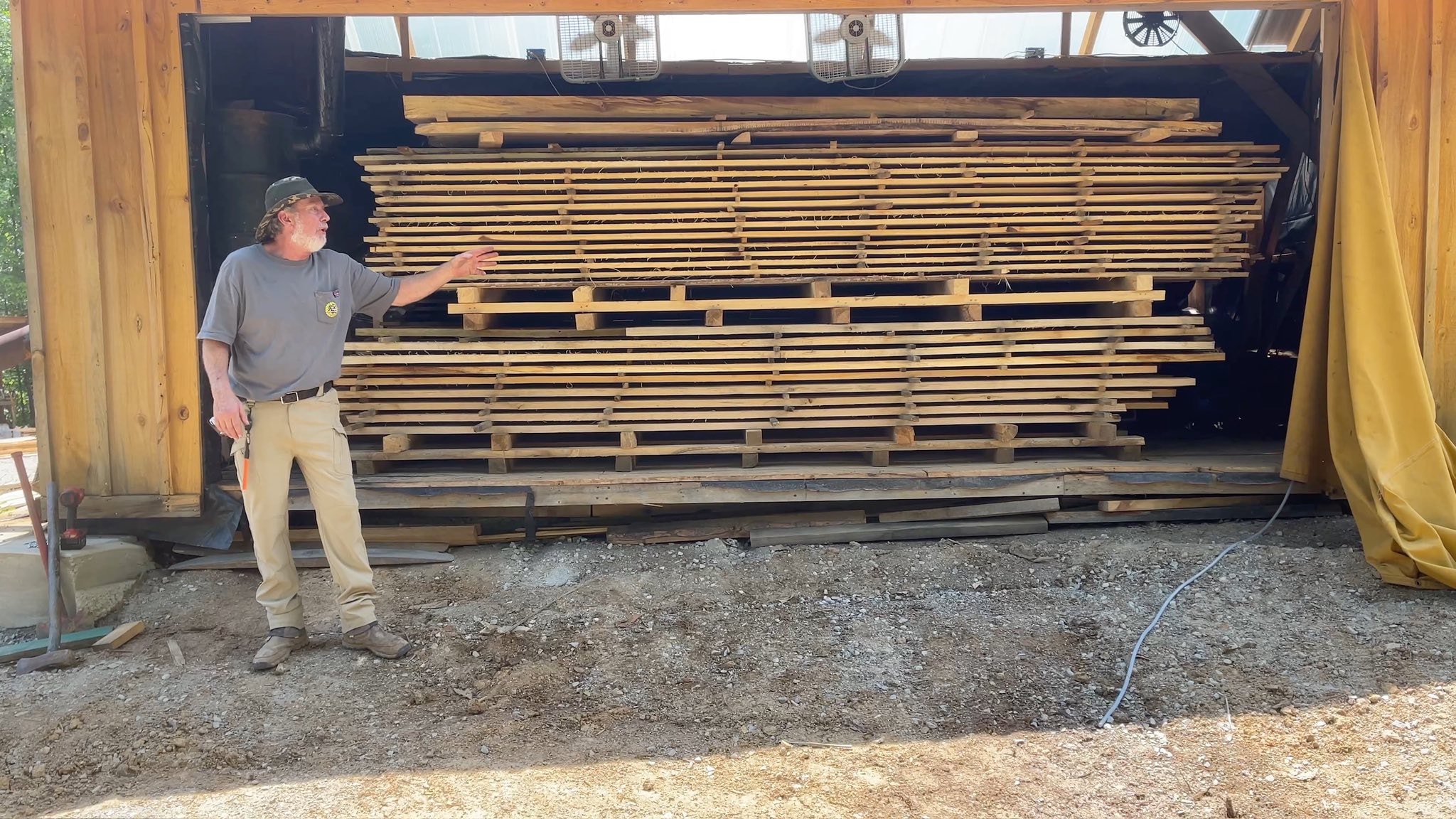
Air Drying Wood
Air drying requires understanding wood and how it works to get the best results. You can air dry wood indoors or outdoors, but it's best to ensure it is covered to rain and the elements can't directly get to your lumber.
The main benefit of air drying is that it's affordable, as you don't have to invest in buying or building a kiln, but that doesn't mean you can just leave your raw wood outside and expect it to dry quickly.
The Pros of Air Drying
-
-
Easily turn green lumber into useable wood without investing time or money into building a kiln
-
You can use your existing garage or lawn space
-
Great for long term planners who have future goals in mind for their wood
-
In general it could take up well over a year for your lumber to dry, depending on your local temperatures and humidity.
Kiln Drying Lumber
So what's the benefit of kiln drying if you can air dry instead?
Wood kilns offer a ton of benefits and can produce high quality lumber much faster and more consistently. There's a reason why many sawyers first projects are kilns. If you have enough space and plan on turning a lot of board feet of wood into useable lumber, you may want to consider building a kiln. In just a few months or even a few weeks you'll be able to see the difference in your lumber.
The Pros of Kiln Drying
-
-
Superior control of the wood's moisture content
-
Better air circulation and humidity control
-
See results much faster than with air drying
-
General Drying Steps
Whether you're drying indoors our outside, in a solar kiln or stacked in your yard, here are the steps required to get your wood dry.
Step 1: Stack and Sticker
This the tried-and-true method every sawyer uses to dry their lumber.
Take your wood, whether it's in slabs or dimensional lumber, and stack it up. Stickers are small pieces of wood placed between each board, normally placed at least a foot away from each end. The purpose of stickers is to ensure air flow between the boards as the wood dries.
If you stack your lumber without stickering it, the stacked lumber dry on the top and on the sides, but the interior layers will take much longer to dry.
Make sure your bottom board is stickered underneath so it's not touching the ground, so it gets optimal airflow on both sides.
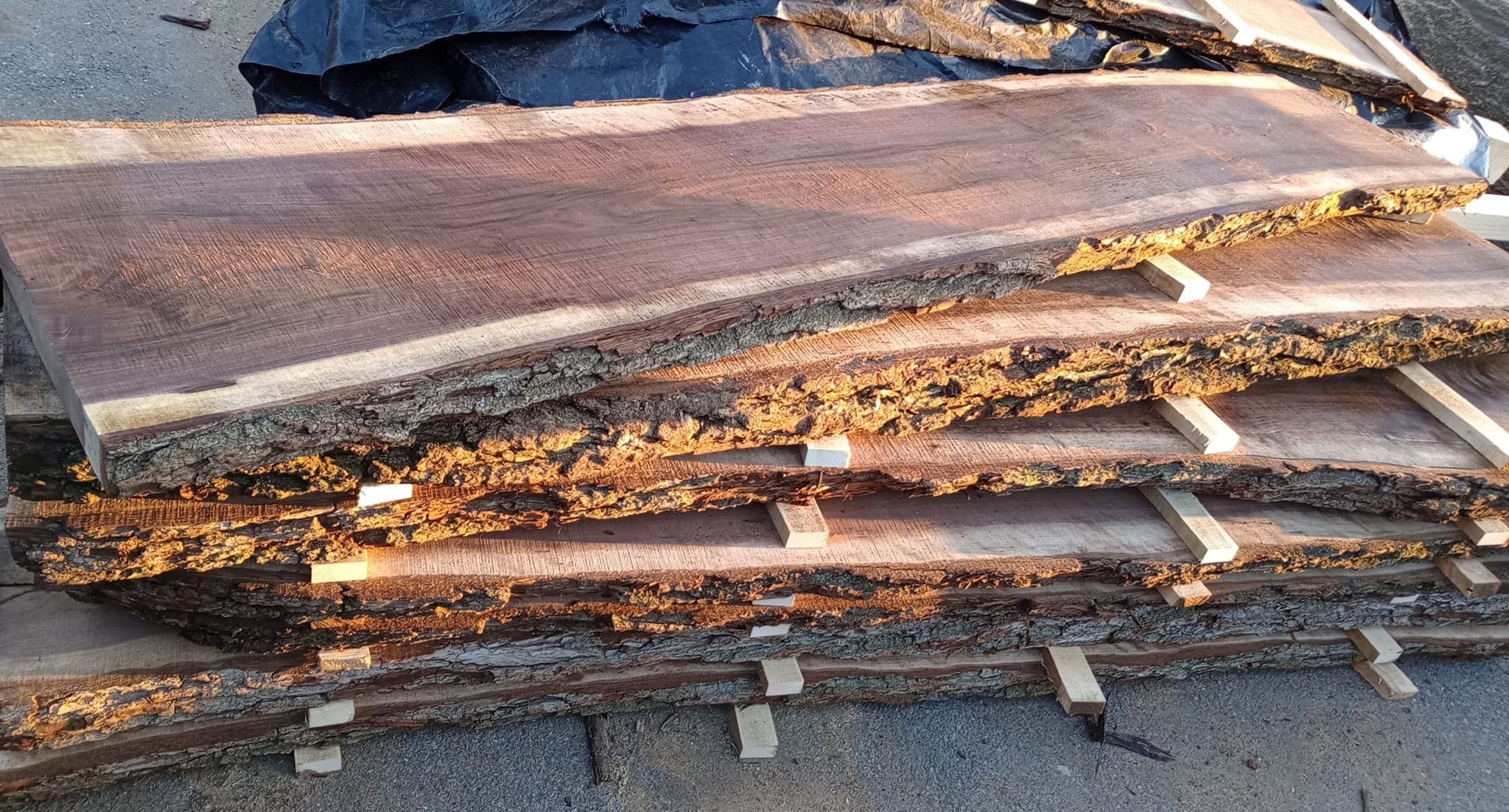
Step 2: Paint the Ends
As the moisture level in the wood decreases, the boards will dry and shrink. This can potentially cause the wood to split at the ends, causing significant damage to the boards if left unchecked.
To resolve this many sawyers will paint the ends, which slows down the drying process in those places and makes it less likely for the wood to crack.
Some sawyers will use:
-
-
Regular outdoor enamel wood paint, applied in at least two coats
-
Specialized wood end sealer, designed to prevent moisture from escaping the ends
-
A homemade mixture of sawdust and glue, made in a 50/50 ratio
-
Step 3: Strap it Down
As wood dries it bends, usually bowing outwards away from the heart of the wood. Because of this, even with stacking and stickering, it's possible for the boards to bend as they dry.
To prevent this some sawyers will use high tension straps to keep the wood flat. To do this they:
-
-
Get two ratcheting straps
-
Place them at least one to three feet from the ends of the boards, depending on the length of the boards
-
Once the strap is wrapped from the bottom board to the top, ratchet it so it's taught and won't flex if the boards start to bend
-
If the boards are continuing to bend despite the ratchet straps, place a third in the middle of the stack
-
Doing this helps ensure boards remain flat and level, meaning they'll be optimal for using for precise projects like building furniture or other wood products.
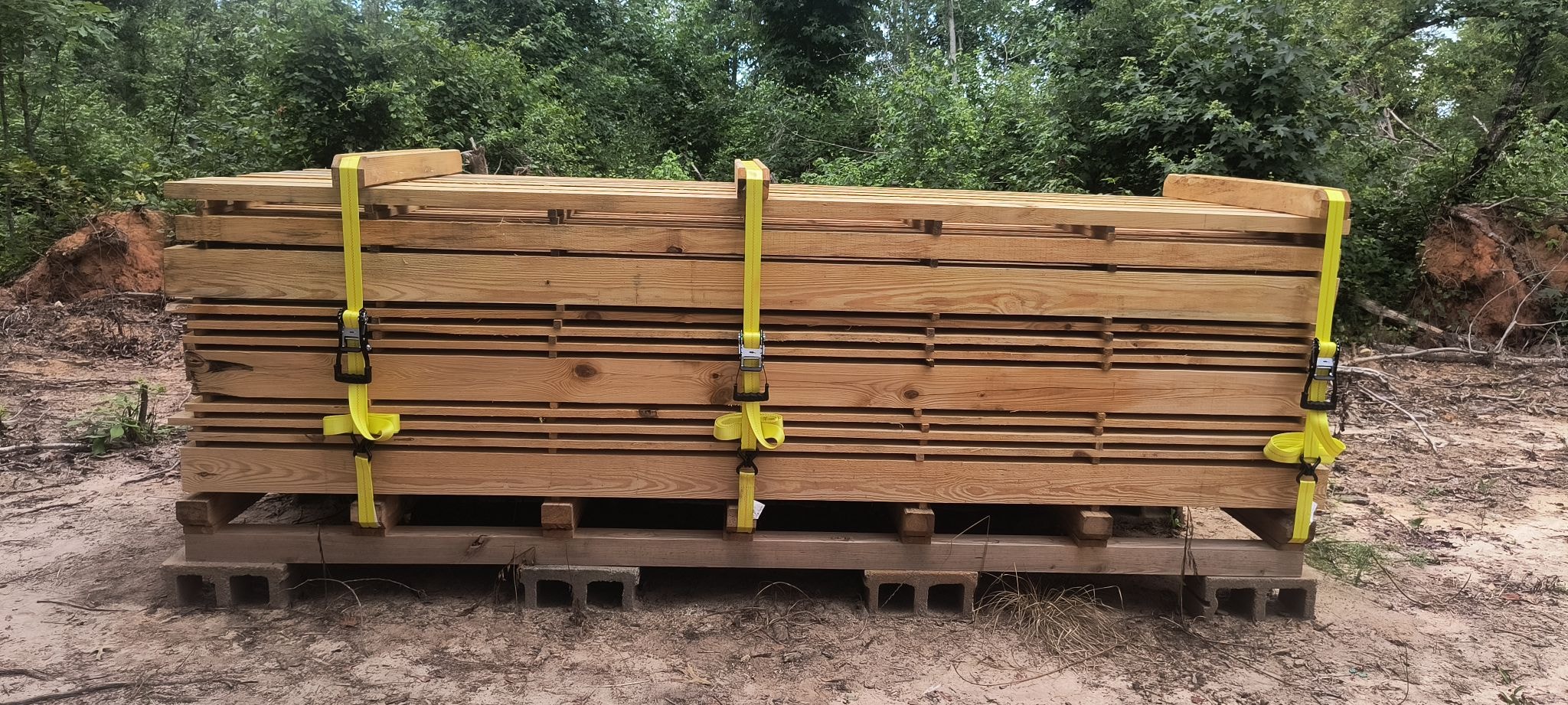
Step 4: Wait Patiently
This is probably the hardest part... waiting.
With enough moisture in the boards, it can take months or even up to a year or more for your wood to reach the optimal levels required for building.
Use a wood moisture meter to check its dryness periodically and tighten the straps if you see your boards start to bend. You can gently correct wood that's drying improperly, but that becomes more difficult as you get further into the process.
Remember, if you dry the wood too quickly, you all but ensure it will bow and crack. Drying takes time so follow all the necessary steps for your boards to end up perfect.
Different Types of Kilns
Before you start your kiln build you should know what type of kiln you want to build first. There are a few common types, and here's what's popular with the sawyers in the Woodland Mills community.

Solar Kilns
Solar kilns, as the name implies, use the power of the sun to help dry your lumber. This is especially useful in warmer climates where you get plenty of sun, but can also be handy in colder climates where an indoor, climate controlled environment is the best place for wood to dry.
Solar kilns work by:
-
-
Using a large window, made of glass, plexiglass or a transparent sheet of plastic to allow sunlight into the interior to heat the wood
-
The environment is sealed so heat stays trapped inside
-
Essentially creating a greenhouse for your lumber
-
Solar kilns are an easy method for kiln drying because they don't require external heating or dehumidification tools, relying solely on the power of the sun.
The benefits of solar kilns:
-
-
They can be built to whatever size you need
-
They don't require power to be supplied to them
-
They're low cost and very efficient
-
The major downside to solar kilns is that they require sunlight, and depending on where you live or the weather for the season, you may not get enough sunlight for solar kilns to be effective. Simply having your wood in a stored environment with captive heat will definitely aid the drying overall, but not as quickly if you don't have the sun on your side.
Dehumidification Kilns
These work much like solar kilns, however they do not use the power of the sun, but instead focus on tight airflow and humidity control to dry your lumber.
These kilns use more modern tools to supply heat and cause wood to dry quickly.
How dehumidification kilns work:
-
-
A heater warms the environment and causes the wood to dry
-
A dehumidifier removes moisture from the air around the wood and takes it out of the kiln
-
Hot air is recirculated throughout the kiln to ensure the wood continues to dry
-
Dehumidification kilns are an amazing tool for pulling moisture out of the wood and turning it into useable lumber quickly.
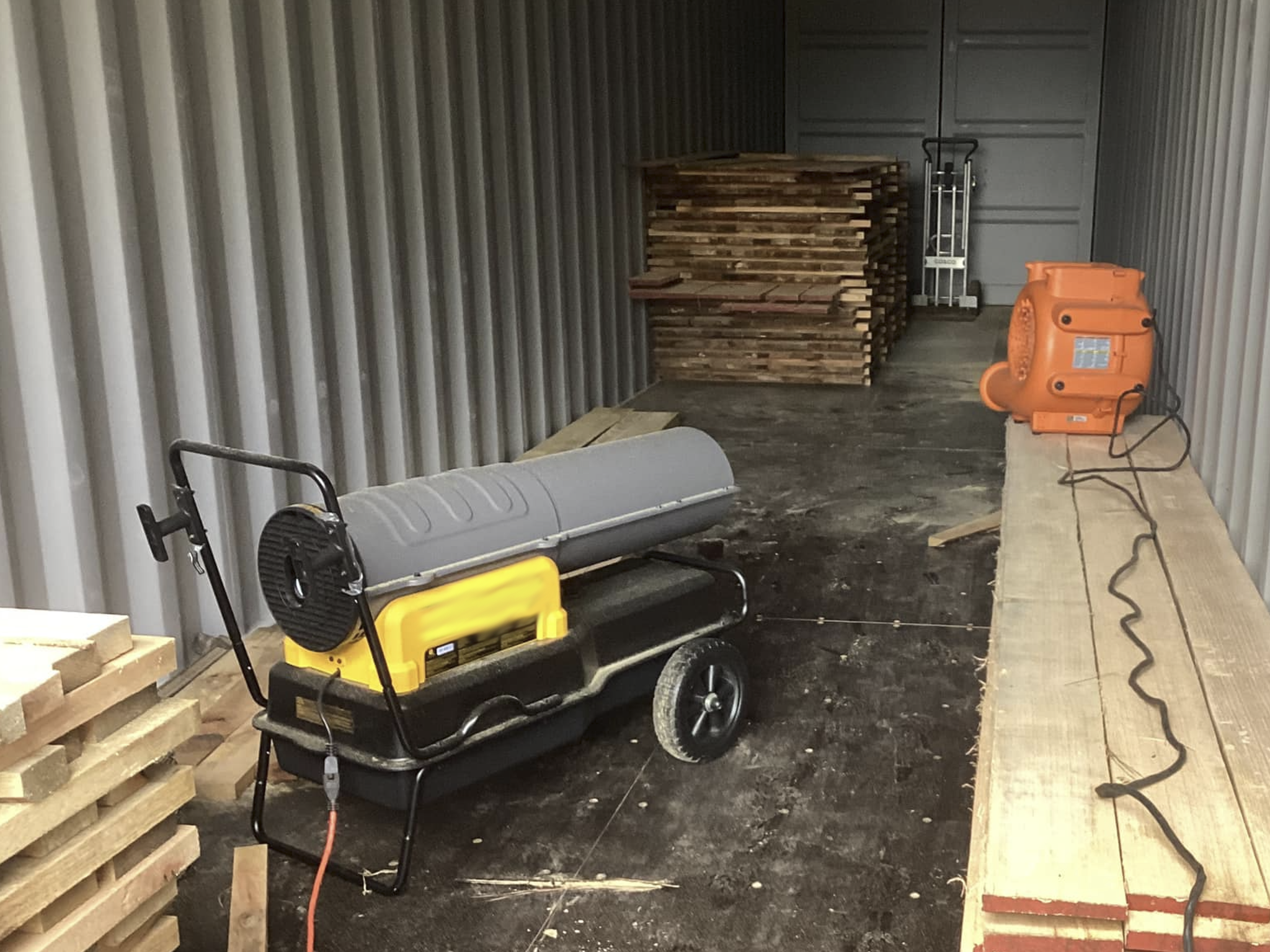
The benefits of dehumidification kilns:
-
-
You have the greatest amount of moisture control
-
You can turn lots of wood into dried lumber quickly
-
They can dry wood much faster than air drying or solar drying, depending on the conditions
-
However there is one notable downside to these types of kilns, and that's the investment required to get them running. These kilns require much more space due to the equipment required to keep them going. They also require a lot of power, since you need to keep the heaters, dehumidifiers and air flow controls running at all times. Some manufacturers do make storebought dehumidification kilns, and these can range from small sheds you can install in your property to vast warehouses for storing rows and rows of lumber.
While this sounds expensive, you can do this at home for a lower cost.
Here's how to make a DIY dehumidification kiln:
-
-
Create your own heat with portable space heaters. Some sawyers like Lee in the Woodland Mills Facebook community use their own wood stove, saying "it seems like a no brainer" to use the residual heat from his stove to warm his adjacent kiln
-
Use storebought dehumidifiers to keep your wood dry. These may require you to dump them periodically or run a vent outside so the moisture has a way to escape while keeping the heat trapped inside
-
Simple rotary fans can help recirculate heat and ensure hot air continues to flow between your stacks of lumber. Solar fans intended for greenhouses make for perfect airflow tools
-
Other tips
What else do you need to know before your start drying your own wood?
Check the Moisture Content
What is the ideal level of moisture content in the wood for building?
That will depend on the species as well as what projects you're planning on using the wood for. Typically if you want to build tables, chairs or furniture, you may want your lumber to be a bit drier. Conventional framing or timber framing actually doesn't require your wood be as dry. While wood will settle and shrink over time, it's more important for tightly-fitted projects like door or window frames.
Some sawyers try to get their lumber to 12% moisture before building with it. Others say they're content with 18%, depending on the project.
Here's some advice:
-
-
Some sawyers like Clifford say they wait until their wood is at 10% moisture before using it, but the wood will continue to dry after it's used. So if you're at 12% then time will take care of the rest
-
Use a wood moisture meter to check the moisture content of your wood. Check every few months or weeks, depending on how quickly you want your wood dry
-
Some sawyers are content to build with green lumber, though you should take into account how the wood will shrink and settle over time.
-
Wood will naturally retain and collect some moisture, so there's not much of a point in reducing its moisture content below 10%, according to various sawyers in the Woodland Mills Facebook community.
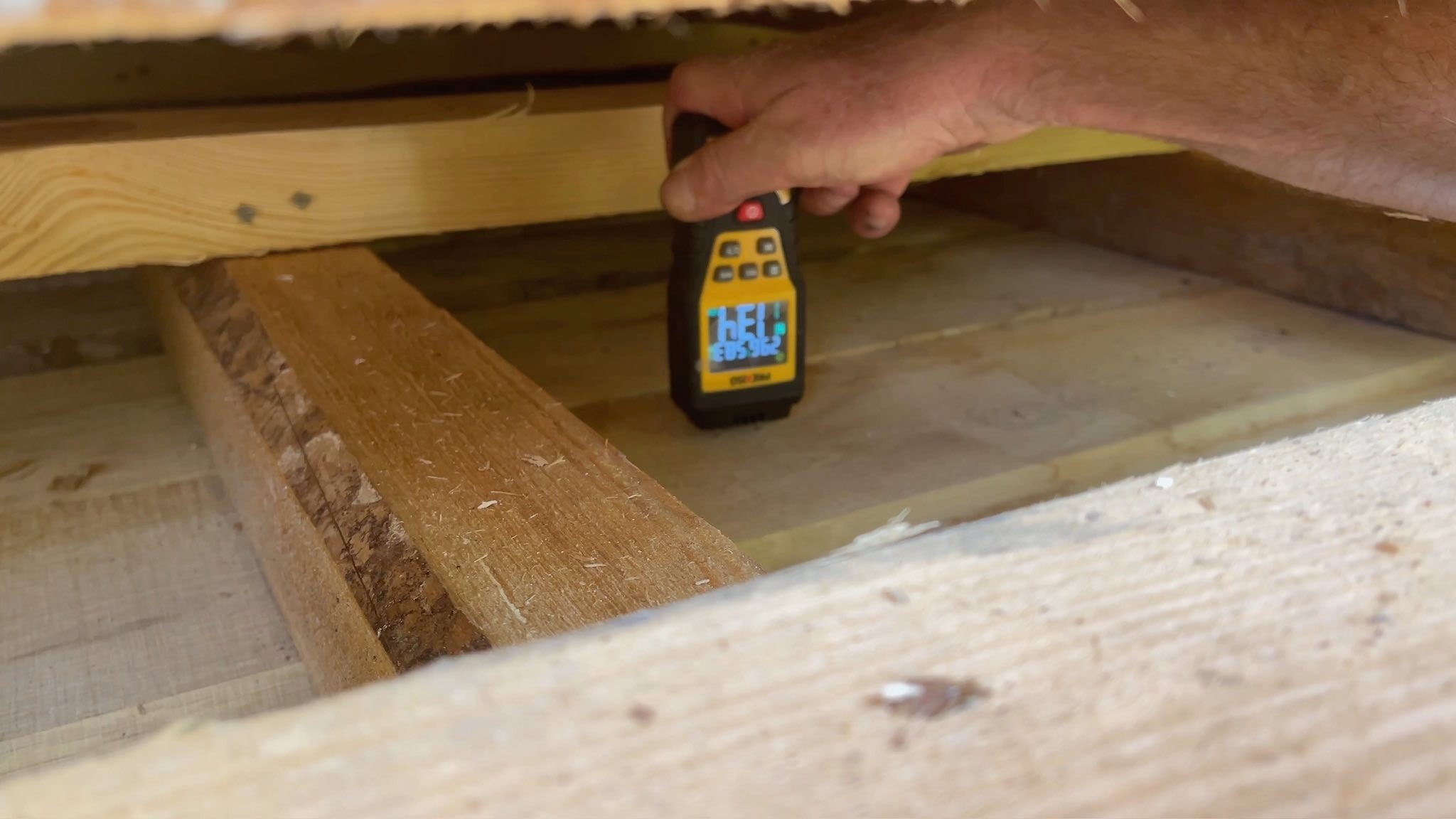
Dealing with pests
Pests like rodents can add an additional layer of difficulty to the drying process, as these critters want to turn your valuable lumber into food or a nest for their own purposes.
You may find you have no issues with pests, in which case there's no need to mitigate them. But if you do find rats, mice or squirrels getting into your lumber, here are some tips.
-
-
Bruce, another Woodland Mills Facebook contributor, suggests setting traps, which you can either buy at the hardware store or set up on your own. He says he uses a bin with bait to lure pests in, so once they fall in they can't get out
-
Keep a cat around, as these natural predators will help catch mice and rats, says fellow sawyer Richard
-
Natural deterrents like oils or soaps that rodents don't like the smell of can help peacefully cause pests to turn the other way, say sawyers Scott and Harmon
-
The drying process itself often kills larvae stored inside the wood, but solutions like Borax are also commonly used for dealing with wood-boring pests
-
Turn your own wood into high quality lumber
Whether you want to build a solar kiln or something more complex, there are plenty of great ways for drying lumber. Take a look at the Woodland Mills Product Owners and Community Facebook group to get ideas for how best to turn your milled lumber into the best materials for your upcoming projects.
So if you're making lumber for your own projects or you're running a business where you need lots of quality wood, building with wet, green lumber is usually not the best. Instead it's a lot easier when you're working with solid materials that you know are designed for the task because you dried them yourself.
So get out there and get stacking.
SHOP TRAILER MOUNTED SAWMILLS
HM122
The HM122 portable sawmill, packaged with the rugged Bushlander® trailer for complete mobility, loaded with features like the RapidChange® blade system, auto lube and more.
HM126
The sawyer favourite HM126 portable sawmill, packaged with the Woodlander® trailer for complete mobility, ideal operation height and easy storage.
HM130MAX®
The wide capacity HM130MAX® portable sawmill, packaged with the Woodlander® trailer for complete mobility, comfortable operation height and easy storage.
HM136MAX™
Our widest-capacity portable sawmill, the HM136MAX™, packaged with the Woodlander® trailer to make it easy to take anywhere and easy to store.
Join the Woodland Mills Community Facebook group. Search advice and insights from over 65,000 knowledgeable, supportive members.
- Pre-purchase considerations
- Sawmill set-up support
- Project inspiration photos and videos
- Community troubleshooting support
